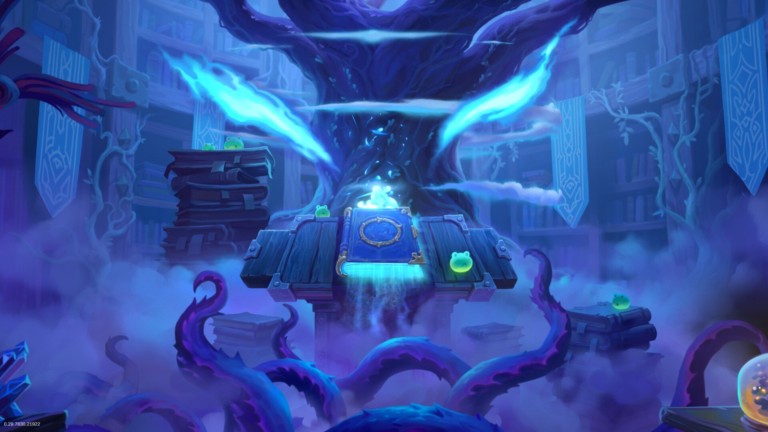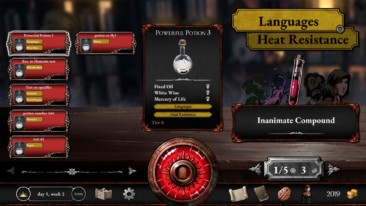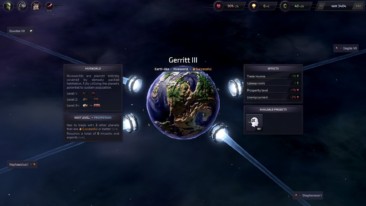Roguebook by Richard Garfield
Roguebook is interesting to me because Richard Garfield is a game-systems master if ever there was one. He has a knack for streamlining extremely complex concepts into manageable, approachable packages like Magic: The Gathering, Bunny Kingdom and Keyforge.
The marketing copy for this new AA Game title from the makers of Faeria is as follows:
“Roguebook gives players the chance to explore the subtleties of Roguebook’s gameplay, such as inserting gems to upgrade the cards in your deck or exploring the world through its ingenious inkwell system, not to mention the concept of the Tower Deck, which reinvents deckbuilding. With this disruptive game system, Roguebook players will want to collect lots of cards in order to unlock new skills for their pair of heroes and create explosive synergies!”
In fact, there is a direct tie-in to the Faeria world, though you’d only really get this from the opening crawl: “The Lore Book, a relic containing all the world’s legends, was lost in a well of Faeria and developed a wicked free will of its own.”
So I was doubly curious and extra excited to see what Richard Garfield teaming up with the Faeria crew could create, especially if they were going to take on a seriously overwrought set of game trends that we see everywhere: Rogue-likes, deck-builders, and Rogue-like deck-builders. Add to that hex-based maps and talent trees and JRPG-style combat using the aforementioned decks.
Though the game is heavily marketed as being a Richard Garfield joint, it is clear that he is lateral and not central to the project as a whole.
To be honest, even with all my hopes and expectations in place, I was tired of Roguebook before it even began. Slay the Spire burnout, I guess. The game would have to do much to reverse this inevitable fatigue with the ubiquity of these sub-genres.
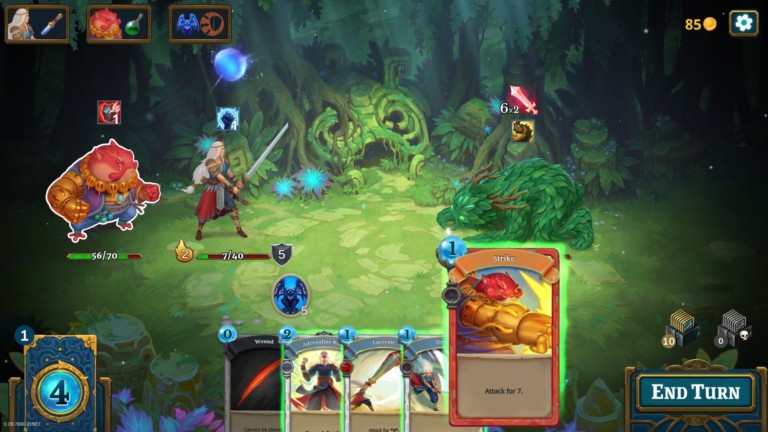
Liveblogging on Entry
Right off the bat, there is a seemingly new mechanic: ink, which you use to paint in the tiles of the map. You can blot a circle of tiles or straight lines to reveal them. At first blush, though, this complexity feels like unwelcome additional tedium. So now I can only move in the direction of the map that my particular collection of paint spatters allows? How is this fun? Is it a puzzle? OK, fine, I guess.
Next in the tutorial, we get a chance to purchase our first card draft. Some of these cards are basic and obvious, deal damage to all mobs, etc., but then we get some classic Garfield complexity: a card that has five different qualifiers. Suddenly, I feel like I am doing 11th-grade math homework. OK, I guess it’ll make sense later when it matters. For now, I have no real idea how it all interacts, but let’s assume it’s a Magic: The Gathering/Keyforge type thing.
Ah, look! A vendor! I have barely gotten a sense of this world or why it matters, and I can already purchase crap to fill it with. I have scarcely had a single encounter with a weakling enemy, and now I have six cards to spend my money on, each with a unique set of features. “Reload,” for example, is “Ranged,” “Stacks” and “Dissolves.” “Bullfrog Berzerker” is an “Ally,” “Aggressive,” and has a “Spirit” value. “Phalanx” has “Block” and “Ally.” Each of these cards has a gold value for purchasing and specific numerical values for their “Block” or “Dagger” abilities. They have action value costs and ally values.
You have to hover over a card to get its details, which is only kind of OK since it doesn’t work if your screen doesn’t have focus. I would have preferred a click to toggle stats on and off, but it turns out that simply clicking the card means you bought it. Oh, OK, then. No confirmation of purchase? Moving on (not).
I still don’t really know what I am doing here.
Banging Our Heads Onward
Into our second battle, we learn that forward and aft positions have meaning, like in Darkest Dungeon. Still waiting to find out if insanity will be a factor here. I draw the card I bought that adds two “Headbangs” to my deck, whatever those are. Oh, OK, here they are now, in my hand.
So…let’s see…this card features…holy crap, that is a wall of text. “Combo”: If the last card played this turn belonged to the other here, this costs 1 energy less. “Stacks” – Can stack multiple copies of itself in your hand. Don’t discard the stack at the end of your turn. ‘Power’ – increases attack damage. ‘Dissolve’ – after playing this card, remove it until the end of combat. Phew. Now that we have the card’s properties out of the way, let’s read its action specifics: Combo, Stacks – Sorocco gains 3 Power for his next attack. Dissolve.
I’m tired. And I have only read the details of one of the five cards in my hand.
I guess I’ll become more familiar with them over time.
What was that marketing copy again?
- 6 hero pairs – Choose 2 heroes to start a game. Each hero has a collection of over 50 cards, a personal relic and a unique skill tree.
- Dynamic deckbuilding – Over 200 cards to cleverly assemble as the game progresses. You will never play with the same deck twice.
- Relics with unique powers – Upgrade your cards with 30 special gems. Collect 80 relics with extraordinary effects.
- More cards, more power! – Each hero has a unique skill tree to unlock. Collect cards and select the best skills!
Hmm…so maybe becoming familiar with each of my cards isn’t really a top feature of the game, since there are more than 700 character combinations, in addition to talent upgrades, permutations, relics and gems.
Well, maybe if we finish the tutorial it will feel less utterly overwhelming, math-y and granular. Onward!
As the cards come out of my deck, and I drag them across the screen at my inert foes, I think back to the hours I’ve spent playing similar titles, throwing math at each other until I can move a few more tiles and find out if I blow it, permanently die and have to start over again, in hopes of…a novel combination of stat soup that I can hurl at the foes.
Fantasy Filler
This isn’t really fun…or original. The archers and swordsmen are wholly uninteresting. At least Nowhere Prophet drew on more Arabic and Southeast Asian themes, music and design and had interesting post-apocalyptic desert robot cults.
Or the wildly imaginative creatures in the slightly mechanical but different Against the Moon. But I digress, as I am daydreaming…
In Zachtronics’ brilliant seminal game Ironclad Tactics, you have lanes that move your units forward every tick. You have to deftly manage your deployments so as to accumulate sufficient Action Points to get anything worked out, looking ahead several ticks across all lanes at once. Like the game Rogue, or those Rogue-likes where things may tick along for you…
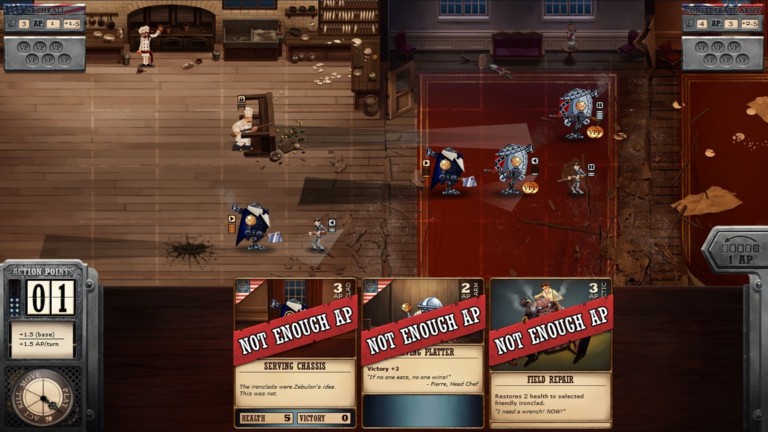
The bottom line is that combat in Ironclad Tactics is utterly fascinating and heart-pounding. And it has an original theme: robots during the Civil War.
Back to the Battles
OK! So what were we doing? Ah yes…reading the details on our cards to bring an end to this tedious combat cycle. My loot is some gold (thrilling) and some ink thing that lets me reveal a random tile on the procedurally generated map. I liked this better in Armello with its delightful winsome isometric anthropomorphic forest creatures.
Hey, look I ran into another chest that gives me 25 gold to draft another card. OK…
Hey, combat again…an ivy monster with 71/71 health. Basically, I look at these hit points like a test of my stamina to stick around long enough to see this combat through. I am thinking about that pizza I left in the fridge last night. How it’s 90 degrees in Los Angeles right now and whether my AC is broken. Oh, and I still need to unbox that copy of Escape the Dark Sector for my real-life tabletop so I can play it with my roommate this weekend…
Strike for 7.
Fire breath for 15.
Lunge for…whatever. Points.
End Turn
Enemy turn.
Now it’s Sharra, Dragonslayer’s turn.
Strike for 7.
Defend for 6.
End turn.
Now the ivy monster – sorry “Seed Sower” (am I really fighting a lawn?) – does a thing.
Now it’s my toon Sorocco’s turn…
I’ll spare you the rest. As Stephen King said about writing, when you are in it, so will be the reader. When you struggle with a paragraph, it will feel like a longeuer to the reader whose thoughts will begin to wander from the page.
Fatigue Sets In
I start to search for a seppuku option where I can ritually disembowel myself upon my sword to restore my honor rather than play out the remainder of this combat exercise.
Finally, it’s over. My Dragonslayer only has 4 hit points left. I grab my paintbrush and drop it on the map, revealing some new tiles. Now it occurs to me that it is at this moment that the map is created and actualized. I see a heart, which I take to mean healing potion. She steps on it and has more hit points now. Another box where I can spend gold to get another card.
Maybe the beloved hex-based epic dungeon crawler Mage Knight was an inspiration here? I hear that game takes a long time to set up. I also loved Dungeon Degenerates, which was about revealing the map across a vast depraved countryside where plague doctors and sex worms rove through the S&M dungeons in hot neon colors.
Oops, my mind wandered off again. I wonder why the team behind Faeria opted for this fairly simple 2D decoupage style? Sure, it has a bit of a Grimm Fairy Tales look, but it’s just so…safe.
Attack.
Block.
Wound cards now fill up my hand, created by the Queen’s Assassin, who looks like the wicked witch Snow White. She has no stats that I can see. All I know is that she intends to attack; whatever cool stuff she has going on under the hood is hidden from me, the player.
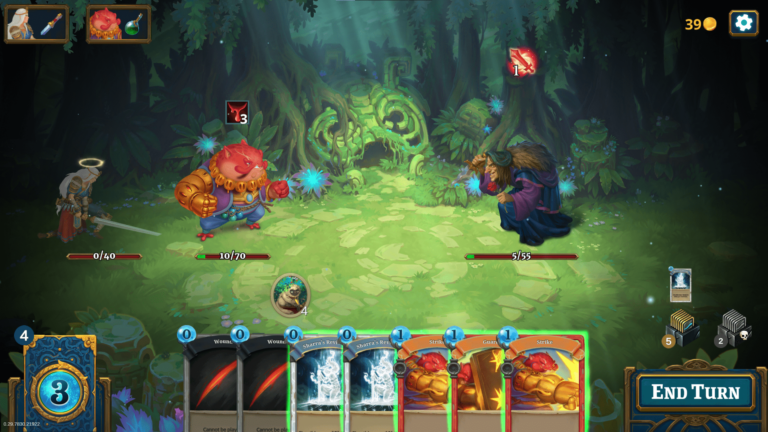
Wow, this is exactly like combat in Slay the Spire, but somehow, despite the extra stat complexity, less interesting. I guess they do have this “front row, back row” thing where the fore or aft position grants advantages.
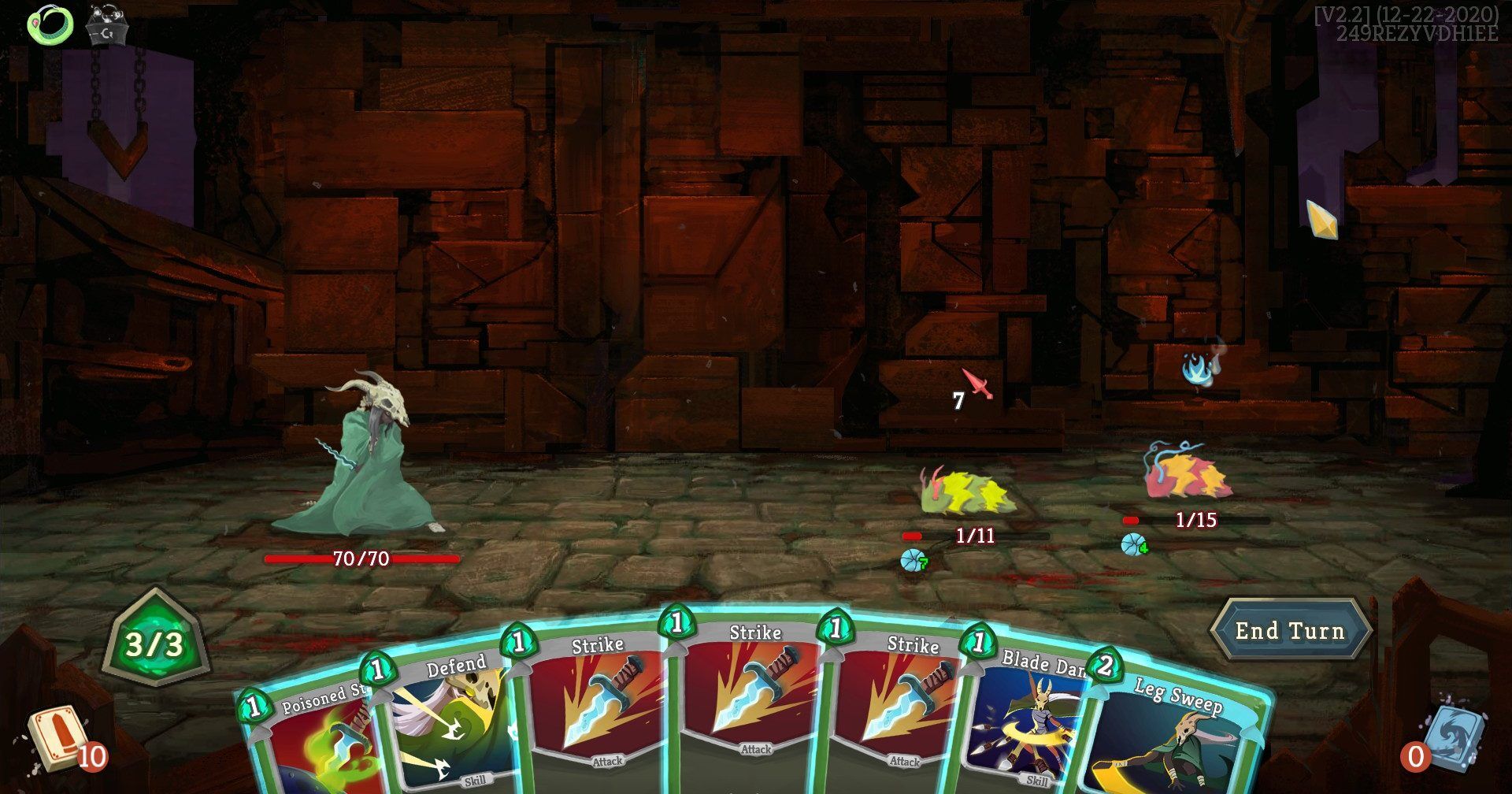
Hey, I was just thinking about that game that made our top ten list in 2019 – Book of Demons where you had these cool procedurally generated 3D isometric dungeon levels and really tough scaling mobs and a killer soundtrack, and it combined real-time action with deck-based combat.
I should go back and see where they are at with their latest updates…
UI Woes Make the Grind Less Grand
I wish I could zoom in and out of the map nicely with my middle scroll wheel, but the zoom is fixed. Additionally, sometimes the map generates an obstacle that makes it impossible to access the resources that you spend your very precious ink on, leaving parts of the map inaccessible. Again, I don’t really understand the benefit of this, since ink can’t be purchased, and once its sources have been exhausted you can do little more than peer wistfully at a map you will never be able to traverse. Oh well, moving on…

OK, I killed the witch character. I get a new bag of loot – a pile of gold, a yak hide that gives me Block, a page that lets me do…something…and hey, neat, another paintbrush so I can inevitably paint more tiles on this map.
So what happens if I don’t get a paintbrush? Does the game just stop? Why do I care about this mechanic?
I walk into another combat and the monkey thing kills me. Game over.
Once More with Feeling
I gain a modicum of experience and return to the beginning. Now I can apply that page I found to an expansive skill tree for permanent upgrades that will enable me to take on commensurately increased challenges. The first of these…places an extra visible treasure in each Chapter. Wow.
Hey, remember that game Ticket to Earth with the groovy tile-matching mechanic where you progressively unlock character skills to trigger powerful tactical abilities during combat? That was neat. Memorable. I often think of that game, years after I first discovered it on the iOS App store…
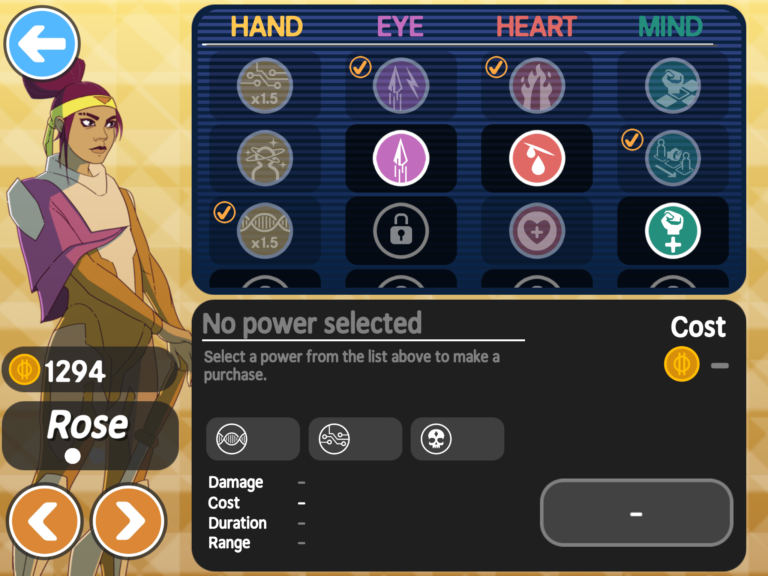
I can choose Sorocco before heading through the gates to begin the game anew. This belies that I will thus utilize my series of unlockable characters. You know, for a procedurally generated game, it would be far more interesting to know that these eventual unlocks are not pre-packaged but rather modular in themselves. A mix and match of parts and skills and traits. That would get my attention.
Emergent Narrative (Yet to Emerge)
In Spry Fox games, which are not unlike what Abrakam has wrought, you have tile-based games with similar combat, but there are stories that carry us between characters that are often truly memorable. There is negligible story-building in Roguebook. You occasionally find a scroll that gives you a static page with a paragraph of text and binary decision. The story is of the type that feels like an afterthought, at most.
As it is, I am tacking on putty to something that oddly feels deterministic, and simultaneously encumbered by its variation. As I push myself to walk across the map anew, I can’t help but wonder again why this painting-in mechanic is necessary. It’s not like anything is coming at me in real-time across the map. Could I not just discover it as I go? Again, I have to assume that there is supposed to be some excitement in painting in the parts I choose to decide at time-of-flight, what the lifted fog of war will present to me, but I just…have no reason to care.
Accentuate the Positives
One nice thing is that when you exit the game midway through a run, it will allow you to pick up from where you left next time your return. Another is this:
You will eventually run out of ink to paint the map. This will force you to meet the Boss, and if you aren’t ready, you are going to die. So the ink-to-map ration/puzzle thing becomes strategically quite important. You have to make sure you hoover up as many resources as you can while you can. In this sense, the game reminds me of Desktop Dungeons, which many years ago I likened to being as addictive as crack and became a viral headline in Australia, of all things.
My point, though, is that there is a nice nuance in the game design here that eventually begins to reveal itself. If you can find one more round of combat, that drops one more paintbrush, which extends the map just a little bit further; then, you may find a chest or more combat that could further extend your adventures and lead you to the more powerful kit to faceoff with the big bad guy.
Interesting.
When you do go to upgrade your skills, you can upgrade them on an individual character level or as a party. I haven’t really seen this anywhere before. I decide to opt for this path every time since it appears that it will benefit my party regardless of who is in it rather than investing in a character I may not choose on my next run. (Update: turns out that the skill is only relevant to the current run.)
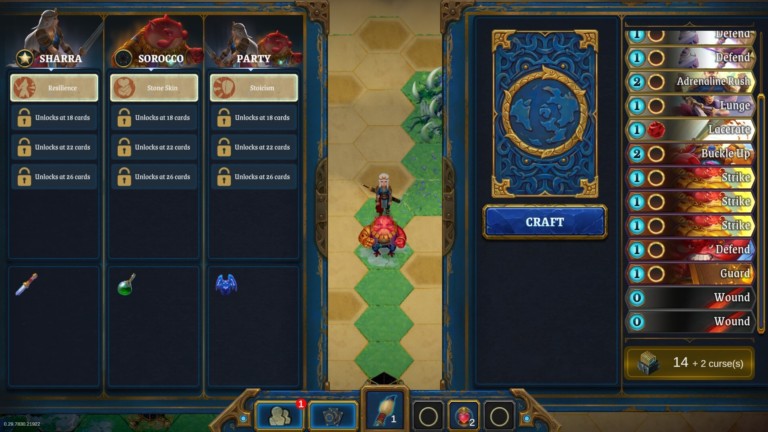
Finally, once you do start to open up the map, it has a touch of the old King’s Bounty series to which I was dangerously addicted. But not quite: the flat map can’t hold a candle to the almost hidden object-style discovery of wonders in that series’ maps. Nonetheless, there is a little bit of joy here for the way that unexpected nooks can show up on the map to save you and keep your adventure moving along just when it seems that you have reached the end of possibilities.
Takeaways
There are things I like here. There is some real machinery under the hood. But in the shadow of games like Endless Legend, Slay the Spire, Ironclad Tactics, Ticket to Earth, Armello and Darkest Dungeon, I wish that Roguebook had had another creative and UX pass.
The first impressions and onboarding are exasperatingly presumptive. The world-building is utterly stingy. The creativity could have been more unbridled, the art less restrained, the tactics more daring, the spells more original. They played it safe, and the game is weaker for it.
I can’t decide if I love this game or hate it. On the one hand, I feel like they did implement some of our favorite gameplay elements from the past few years. On the other, the experience feels very close to its influences.
I’m going to lean in on the chance that I might come back to it again and appreciate it a little more on the next go, with my expectations adjusted accordingly. I expected a lot, and with so many moving parts, I am not yet certain what I really got. It is not a dazzler out of the box, but it might be a sleeper. If you remove all the tracing paper, it might even be really good.
Roguebook is available via the Nintendo Game Store, Sony PlayStation Store, Microsoft Store and Steam.
Check out the official Roguebook trailer below:

